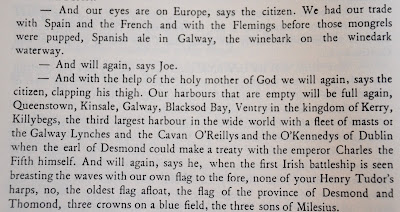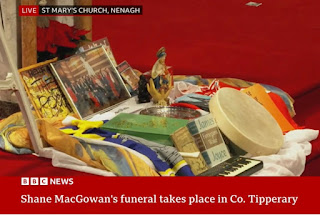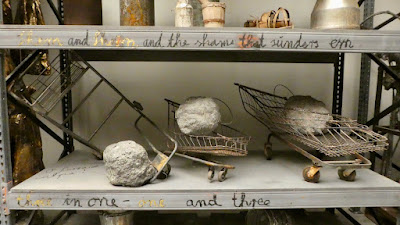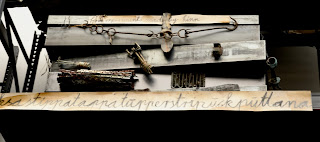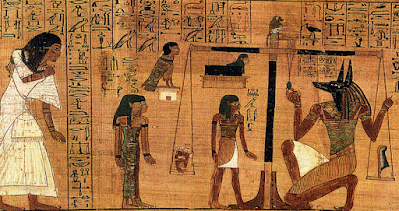 |
| Happy Christmas Your Arse tree ornament |
Today the great Shane MacGowan, poet, songwriter, musician and Joyce lover, made his last journey from Dublin back to his spiritual home in North West Tipperary. Like countless people, I was hit by the news of his passing. For the last week, I've been wearing my Brixton souvenir "Just Look them Straight in the Eye and say Pogue Mahone" t shirt.
In our house, Christmas Day is Shanemass. Nobody knows when Jesus Christ was born but we do know that Shane MacGowan was born on 25 December 1957.
I first saw the Pogues, supporting Elvis Costello, at the Top Rank Brighton on 3 October 1984. It was a life changing experience. I loved everything about them from Shane's powerful voice to their Black Irish Drinking Suits. I didn't know much about Irish music then, and the songs all sounded like ancient standards. It wasn't until their first album, Red Roses for Me, came out later that month that I found that six of the best of them were brand new songs written by Shane.
Here's the very first song Shane wrote for the Pogues, a dream of a meeting with his hero, Brendan Behan.
The outstanding line here is "There was nothing ever gained by a wet thing called a tear" which sounds so simple and beautiful yet I don't know if anyone else ever said or thought that before.
Shane's writing was full of lines like that e.g. "Some people left for heaven without warning" from Sally MacLennane and "The cold things that follow you down the Boreen" from Sit Down by the Fire.
Behan was also an inspiration for Sea Shanty, a great song about a wild seafarer, washed up and stranded on dry land.
"Dear dirty London in the pouring rain
I wish to God I was back on the sea again
Though that belongs to the world of never will be
There was never a wilder bastard than me on the sea"
Here Shane has taken one of Behan's favourite sayings, "The compliments pass when the quality meet" (which appears in Borstal Boy, The Hostage and Confessions of an Irish Rebel) and made it fresh.
On the page, the phrase looks like a mouthful, but the rhythm Shane gets into the line is so satisfying that he decided to sing it four times.
"I met with Bill James and we fought over crusts
I called him a whore and he booted me crutch
Then we shared out the jack and we thought it a treat
The compliments pass when the quality meet
The compliments pass when the quality meet
The compliments pass when the quality meet
The compliments pass when the quality meet"
It wasn't until Shane's lyrics were published by Faber as the book Poguetry in 1989 that I realised he was also quoting from Ulysses on the first album:
From Surrey Docks to Somers Town
With a KMRIA"
KMRIA stands for "Kiss my royal Irish arse" and comes from the newspaper chapter, where the book starts playing games and generating newspaper headlines from the text (the game-playing narrator is known to Joyceans as "the arranger"). It's a play on MRIA, standing for 'Member of the Royal Irish Academy'.
The band's original name "Pogue Mahone" also means "kiss my arse". That's in Ulysses too, where it's Buck Mulligan's reaction to the prospect of hearing Stephen Dedalus talking about Thomas Aquinas.
Fare thee well, gone away, there's nothing left to say
With a slainte Joe and Erin go my love's in Amerikay
The calling of the rosary, Spanish wine from far away
I'm a free born man of the USA
Kevin E Perry, 'A Liquid Lunch: In Bed With Shane MacGowan' The Quietus in 2012
While writing this I've been watching Shane MacGowan's immensely moving funeral live on the BBC. His copy of Finnegans Wake has just been displayed as one of his symbols! Victoria said the book was 'another of Shane's favourites'.
John Hewitt made the meaning explicit in his illustration from the book.
The name was suggested by Spider Stacy. Here's how James Fearnley tells the story in his excellent Joyce-titled memoir, Here Comes Everybody:
When I shared this on twitter, Spider posted this.
I think there are other echoes of Ulysses in Shane's songs. Here's a verse from one of his greatest songs, The Body of an American:
With a slainte Joe and Erin go my love's in Amerikay
The calling of the rosary, Spanish wine from far away
I'm a free born man of the USA
"Spanish wine from far away" always makes me think of this speech from the citizen, Joyce's cyclops, in Barney Kiernan's pub:
Joyce made an appearance on the sleeve of the Pogues third album, designed by Simon Price.
This is a 1928 studio portrait of Joyce taken in Paris by Berenice Abbott.
One Joycean feature of Shane's writing is the evocation of place, by naming real pubs, cafes and streets, many in north and west London: Dalling Road, Valtaro's in Marchmont St, the Kardomah, the Centrale cafe in Soho, the Euston tavern, the Scottish Stores pub by King's Cross, the Vine street police station....
It would be easy to do Shane MacGowan guided walks around London. Shane's equivalent of Bloom's gorgonzola sandwich in Davy Byrne's would be 'a fried egg in Valtaro's'.
He did the same for Tipperary in The Broad Majestic Shannon.
Shane was reading Joyce from a very young age, thanks to the influence of his father Maurice. In 1971, the Kent and Sussex Courier reported that at the age of 13, he had won a Daily Mirror essay prize with his short story about a group of meth drinking Irish social outcasts.
Shane told the paper that his favourite author was James Joyce.
There's a lot about Joyce in A Drink with Shane MacGowan, Victoria's book of conversations with Shane.
– Do you think that Joyce is overrated?
– No
– What do you think about James Joyce?
– I think he's underrated.
– Do you?
– Yeah.
– Even though he's supposed to be the greatest...
– I think he's underrated, apart from by the Americans, you know....
– So why is James Joyce considered the greatest, and why do you like him so much? Why do you think he's so good.
–Cause he really rearranged the English language, because he didn't like it the way it was....He made up his own language, that's what I like about him, y'know. Which is a mixture of Irish and English, and Latin and Greek, and just being pissed.
....He had countless affairs...And not only did he used to chat them up, he used to sing them up with his fabulous tenor voice. He used to get a few jobs, and then do a hymn, or a piece of opera, or an old Irish ballad...in this fabulous tenor voice, and the girls would melt...into his arms, and he'd have it away with them. He was an opportunist like that. And he had a long suffering wife who put up with it all."
A Drink with Shane MacGowan
In 2012, Shane also talked about Finnegans Wake in an interview:
"Literature is just stories. One of the greatest works of literature is Finnegans Wake by James Joyce. The inspiration for that came from 'Finnegan's Wake' which is a great story-song. Nobody knows who wrote it, it's so old. Well, it's not that old. It's 200 years old maybe. People just used to pass it down, as often happened at wakes. That's what wakes are for. People would start off being very nice about the person, then there'd be more and more slanging and then they'd have a huge row and all the rest of it. If that didn't wake them up then they must be dead, yeah?.....
In his later years Joyce was nearly blind and he was using a typewriter that he was constantly having to hock and get out again. There were two or three bum letters on it so he didn't know exactly what was going to come out. He had bad eyesight, a bad back, all the rest of it. In those days a doctor would write you a prescription for everything, and he was a boozer from an early age."
I don't think Joyce ever typed anything, but that's a great story and an example of Shane's amazing imagination. In his mind, he turned Joyce into a mythic character.
You can find more than 50 references to Pogues and Poguing in the Wake, listed here in fweet.
'kissing and spitting, and roguing and poguing' 22.25
"Pogue! Pogue! Pogue!' 376.21
'and he poguing and poguing' 385.32
'so pass the pogue for grace sake. Amen.' 395.24
Here's a picture of Shane reading the book in 2005 posted on twitter/X from Dr Dickon Edwards
I remember when Edwards originally posted this in his diary, he said that Shane was 'rereading' the Wake.
While writing this I've been watching Shane MacGowan's immensely moving funeral live on the BBC. His copy of Finnegans Wake has just been displayed as one of his symbols! Victoria said the book was 'another of Shane's favourites'.






